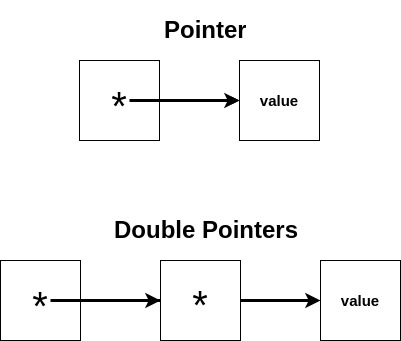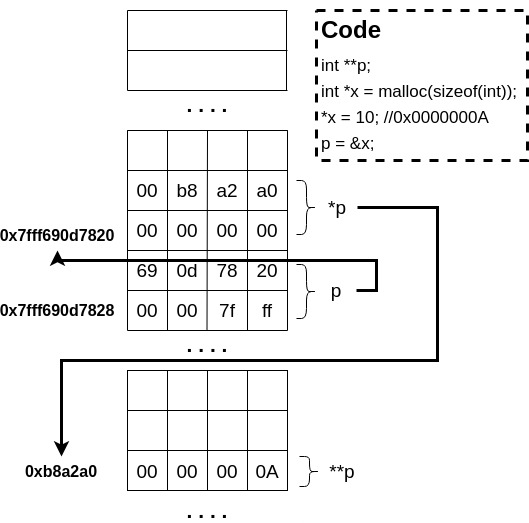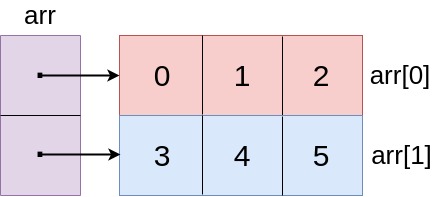I was randomly browsing r/CarletonU community on Reddit since it’s one of the schools I may attend next Fall. A particular post interested me due to the title: For anyone in Computer Science. As a recent graduate in Computer Science (undergrad), this post caught my attention. This blog post is inspired by my response on reddit about double pointers.
Today I want to discuss with you two use cases for double pointers: making modifications to a pointer in a function and in 2d arrays.
TOC
What is a double pointer
Before I can delve into the use case of double pointers, it’s best to refresh your minds on what a double pointer is. If you already have an understanding of how double pointers work, you can safely pass this section. Based on the name itself, we can infer that it involves the use of two pointers. A double pointer is a pointer to another pointer. We know a pointer is a data type that stores some address as its value. Therefore, a double pointer is a data type where it stores an address of another pointer which itself points to another address in memory. Sounds confusing, doesn’t it. It makes more sense if we see a diagram of how this works:

A diagram to visualize in a high level how pointers work
As you can see from the diagram above, the first pointer points to another pointer which points to some data such as an int. The post on reddit that motivated me to write a blog about double pointers has a good literary illustration on how double pointers work. Written by robby105, he tries to describe pointers as a mailbox where the value is the mail itself in which he refers it as a page.
So basically it's like using a pointer for a normal data type. Because all pointers are, are just a
reference to a location. So it's like a mailbox, all it does is hold a value of a an address.
Then in that address is the value inside of it.
So here is an example, you have a mailbox called P. And inside the mailbox there's a page with the
value 123 Carleton Avenue. So then you drive to 123 Carleton Avenue and you check in that mailbox
nd you see the value is 50. So here mailbox P is a pointer to the variable N that holds the value of
50, but all P is the address of N. Nothing else. So by understanding that a double pointer is just
a pointer to another pointer that holds the address to some variable.
I hope you are able to follow the blog up to this point. Pointers are confusing and are the cause of great headaches even to experienced developers and this can be seen through all the exploits that exist due to improper use and protection on pointers. Perhaps it’s also a great idea to see how double pointers work in the memory with a diagram (You can skip this section. It’s quite long).
Representing Double Pointer in Memory

A diagram displaying how double pointers look like in memory formatted in big endian
In the diagram above, p has the address 0x7ffff690d7828. Since p is of type int **,
the value of p will be another pointer of type int *. Therefore, the value of p should be
another hex value representing some location in memory. Which we indeed have as shown in the diagram
above where the value is 0x7fff690d7820. As a side note, the diagram orders the bits in
big-endian, where the lowest significant bits are stored at the highest address. You are probably
used to seeing bytes ordered in little-endian because of your CPU (i.e. x86 and AMD64/x86-4
series). I didn’t notice this when I was making the diagram a few nights ago but we’ll just have to
live with it for the time being.
On another tangent, the size of pointers in the diagram is 8 bytes. This is why you see 0 paddings at the start of the lowest bit in memory (they represent the highest bit of the address pointed by our pointers) since the addresses we are working on aren’t pointing to any address that requires all 8 bits to represent it.
Anyhow, back to explaining the diagram. The value of p is 0x7fff690d7820, a location in memory that contains another pointer that gives us the address of the integer data we want. Following the location where p points to (by dereferencing p), we find that the integer we want is stored in the address 0xa0a3b8. Therefore, if we go to that location in memory (**p), we should see the integer value which I set it to 10. Long and behold, 0xa0a3b8 does contain the value 10 which is represented in hex as 0x0A.
When Should I Use Double Pointers?
On top of my head, there are two main scenarios where using double pointers makes sense:
- Mutating a pointer’s value in another function
- Representing “Complex” Data Structures
Use Case 1: Mutating a pointer's value in another function
There are scenarios where you would want to change the value of a pointer outside the function where you defined the pointer. In such cases, simply reassigning the pointer in a function will not suffice. Here’s an example of trying to make a memory reassignment fruitlessly:
void invert_point(int *x, int *y) {
int *temp = x;
x = y;
y = temp;
printf("\tSwapping (x,y) to (y,x)\n");
printf("\tThe pair is now (%d, %d)\n", *x, *y);
}
int main () {
/*****Allocation*****/
int **point = malloc(sizeof(int *) * 2);
point[0] = malloc(sizeof(int));
point[1] = malloc(sizeof(int));
*point[0] = 5;
*point[1] = 1;
printf("===Before Swap===\n");
printf("Address of (x, y): (%p, %p)\n", point, point+1);
printf("Values of (x, y) : (%d, %d)\n", *point[0], *point[1]);
invert_point(*point, *(point+1));
printf("===After Swap====\n");
printf("Address of (x, y): (%p, %p)\n", point, point+1);
printf("Values of (x, y) : (%d, %d)\n", *point[0], *point[1]);
/*****DeAllocate*****/
free(point[1]);
free(point[0]);
free(point);
return 0;
}
Example 1:The code attempting to swap a point on a graph fruitlessly
In Example 1, we have a pair of integer pointers representing a point on a graph. The function invert_point swaps x and y. If we were to compile and run Example 1, you’ll quickly notice that there has been no change at all despite appearing so in the function invert_point.
===Before Swap===
Address of (x, y): (0x15352a0, 0x15352a8)
Values of (x, y) : (5, 1)
Swapping (x,y) to (y,x)
The pair is now (1, 5)
===After Swap====
Address of (x, y): (0x15352a0, 0x15352a8)
Values of (x, y) : (5, 1)
Although it may be confusing at first because it may seem like Example 1 should work since we pass in pointers to the function. It does not achieve the desired effect because the variables x and y in the function compare are copies that contain the value where the integers are stored (we call this call by value). Any modification to x and y only swaps the copies and does not make any modification to the desired variable defined by the calling function (main). Therefore, you must pass in a double pointer to the function compare to make the swap affect the pair defined in main.
void invert_point(int **x, int **y) {
int *temp = *x;
*x = *y;
*y = temp;
printf("\tSwapping (x,y) to (y,x)\n");
printf("\tThe pair is now (%d, %d)\n", **x, **y);
}
Example 2: The correct implement to swap a point on a graph properly
If we were to compile and execute the program, we’ll get the desired output as seen below:
===Before Swap===
Address of (x, y): (0x1a322a0, 0x1a322a8)
Values of (x, y) : (5, 1)
Swapping (x,y) to (y,x)
The pair is now (1, 5)
===After Swap====
Address of (x, y): (0x1a322a0, 0x1a322a8)
Values of (x, y) : (1, 5)
I wonder if you noticed, but this example is very similar to the classical example of swap. For those of you who never read K&R, a classical book on C, swap is an example in the book to illustrate why pointers are needed to alter a variable in the calling function. Altering double pointers in the calling function can be reduced to swap since altering a pointer is just an extension of altering a non-pointer variable. Double pointers is just an extension of single pointers, just an additional layer of indirection.
Representing "Complex" Data Structures
Often we will be working with data structures that are more complex than the primitive data types in C. Primitive data types include int, char, etc. Some more “complex” data type requires the use of double pointers to implement the data structure. An extremely simple example is a multi-dimensional array. As the name implies, a multi-dimensional array is simply an array of arrays (i.e. having more than one dimension). A 2d array is composed of an array where each element is another array as seen in Example 3.
# Let's say we want a 2x3 array
# 2 row x 3 cols
[
[0, 1, 2],
[3, 4, 5]
]
Example 3: An example how 2x3 array looks like in Python
A motivating example where 2d arrays are used is in representing a matrix in Mathematics. A matrix is a set of numbers arranged in rows and columns to form a rectangular array. A matrix is an abstract concept but it’s widely used in many fields. A simple example of a matrix that is relatable to most humans is representing an image. More on that later.
Relation of arrays with Pointers
A regular array is similar to a regular pointer in C. For instance, in the example below, you have a
regular pointer to an int named x and an array of int named arr. arr is just a pointer to
the first element in the array we allocated and it looks oddly similar to x, an integer variable.
Except, we reserved 5 consecutive blocks of size int for the array (i.e. total size is 5 *
sizeof(int) which is typically 20 Bytes in a typical system).
int *x;
int *arr = malloc(sizeof(int) * 5); //arr[5]
But when we are working with multi-dimensional arrays, you need more than one pointer. If we are working with a 2d array, you’ll need two pointers. The first pointer is an array of pointers where each element in the array points to another array. It’s confusing on words so let’s see a diagram:

A diagram displaying how a 2x3 matrix looks like in C
As seen from the diagram above, the arrays [0, 1, 2] and [3, 4, 5] are
members of the parent array. A 2x3 array is composed of a parent array of size 2 to represent the
rows while the nested arrays are of size 3 to represent the width of the matrix.
How do we represent an array in C? As stated earlier, we represent an array using a pointer. And if each element in the nested array is another array, then it should make sense that the outer array (the parent array) is just an array of pointers as seen in the diagram above.
arr2d = { addr_a, addr_b }
addr_a = { 0, 1, 2 }
addr_b = { 3, 4, 5 }
Recall that we want to create a 2x3 array. As you can see, the first array is an array of 2 elements. So if we write that in C, it’ll look something like the following:
int **arr2d = (int **)malloc(sizeof(int *) * 2);
Now we have a variable named arr2d that can store 2 pointers. But these pointers don’t point to anything useful currently (it points to some random value in memory). Therefore, we need to have the array point to our two nested arrays.
We’ll allocate memory to create the nested two arrays and have arr2d (the parent array) to point to them as shown below:
arr2d[0] = (int *)malloc(sizeof(int) * 3);
arr2d[1] = (int *)malloc(sizeof(int) * 3);
So if we put this all together, we have the following:
int row_size = 2;
int col_size = 3;
//allocate the array of pointers
int **arr2d = (int **)malloc(sizeof(int *) * row_size);
//allocte the first row of integers
arr2d[0] = (int *)malloc(sizeof(int) * col_size);
//allocate the 2nd row of integers
arr2d[1] = (int *)malloc(sizeof(int) * col_size);
for (int row = 0; row < row_size; row++) {
for (int col = 0; col < col_size; col++) {
arr2d[row][col] = row*col_size+col;
}
}
//display the array
for (int row = 0; row < row_size; row++) {
for (int col = 0; col < col_size; col++) {
printf("%d ", arr2d[row][col]);
}
printf("\n");
}
free(arr2d[0]);
free(arr2d[1]);
free(arr2d);
The output should be:
0 1 2
3 4 5
As a side note, to free your 2d array, you need to free the nested arrays first. The trick is to free in the order of a stack (FILO).
Why do we even need to allocate a 2d array in a heap anyway?
There are cases when creating a 2d array in a stack makes sense and when heap is more appropriate area to allocate your 2d array. Consider the following:
If we were to define a 2d array in the stack, we would write something like the following:
void read_img() {
int arr2d[2][3];
...
}
Once the function read_img terminates, arr2d no longer exists (i.e. we no longer have access to
the data, it’s out of our scope, and can be overwritten since it’s free for anyone to overwrite
it). Allocating to the heap can avoid this issue. Though, you must ensure you store the address
somewhere safe, or else you’ll have a memory leak.
Also, we also face memory size constraints. The heap provides us with more memory than what the stack provides us. Let’s say we use the 2d array to read some very large black and white image, we may not have enough space to even store all the pixels in the array. Therefore we need to allocate on the heap where you can allocate very large chunks of memory.
In addition, creating a 2d array on the stack means that the size is fixed. We cannot resize the array to be larger or smaller. Allocating a 2d array on the heap gives us the ability to dynamically resize the array.
Pointers are confusing. Anyhow, I hope my pointers about pointers don’t make you more confused about the confusing nature of pointers (probably a terrible joke).
